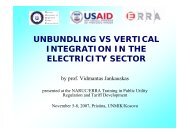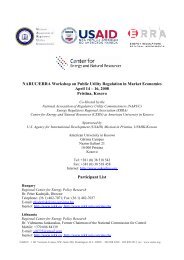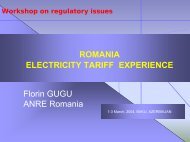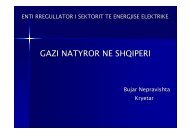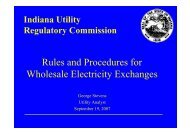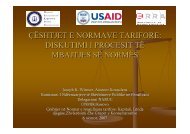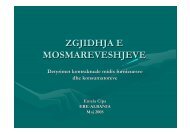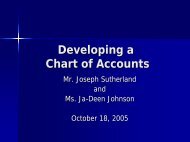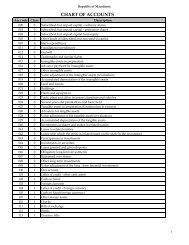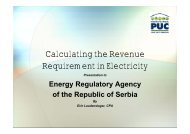The Structure of Electricity Costs and Pricing Policies in Albania
The Structure of Electricity Costs and Pricing Policies in Albania
The Structure of Electricity Costs and Pricing Policies in Albania
You also want an ePaper? Increase the reach of your titles
YUMPU automatically turns print PDFs into web optimized ePapers that Google loves.
<strong>The</strong> <strong>Structure</strong> <strong>of</strong> <strong>Electricity</strong> <strong>Costs</strong><br />
<strong>and</strong> <strong>Pric<strong>in</strong>g</strong> <strong>Policies</strong> <strong>in</strong> <strong>Albania</strong><br />
Indrit Baholli<br />
Tariff <strong>and</strong> Prices Department, ERE<br />
Tirana, September 19, 2007 1
Role <strong>of</strong> ERE <strong>in</strong> <strong>Electricity</strong> <strong>Structure</strong><br />
• ERE plays a key role <strong>in</strong> the strategic structure <strong>of</strong> the electricity<br />
ty<br />
sector. It is armed with substantial powers <strong>in</strong>clud<strong>in</strong>g licens<strong>in</strong>g <strong>of</strong><br />
market operators, review <strong>and</strong> approval <strong>of</strong> electricity tariffs, <strong>and</strong><br />
monitor<strong>in</strong>g <strong>of</strong> all licensees. It is empowered to issue regulations<br />
enforc<strong>in</strong>g the Law, to protect consumer <strong>in</strong>terests, resolve disputes<br />
between market operators or between operators <strong>and</strong> consumers,<br />
<strong>and</strong> to co-operate operate with other electricity regulators on the<br />
<strong>in</strong>ternational level.<br />
• ERE's primary goals are to protect consumers, licensees, <strong>and</strong> market<br />
competition. One <strong>of</strong> the ma<strong>in</strong> tools to achieve <strong>and</strong> ma<strong>in</strong>ta<strong>in</strong> this<br />
objective is through tariffs. In its activity to rationalize the tariffs,<br />
ERE should consider that:<br />
• Price signals have to reflect costs, dem<strong>and</strong>, <strong>and</strong> lead to efficient<br />
uses <strong>of</strong> electricity.<br />
• Supply costs should be fairly allocated among customer categories.<br />
Tirana, September 19, 2007 2
Role <strong>of</strong> ERE <strong>in</strong> <strong>Electricity</strong> <strong>Structure</strong><br />
• Tariffs must reflect cost differences between various categories <strong>of</strong><br />
customers.<br />
• ERE should ensure that tariffs are non-discrim<strong>in</strong>atory, transparent,<br />
<strong>and</strong> reasonable based on widely recognized ratemak<strong>in</strong>g pr<strong>in</strong>ciples.<br />
• ERE ma<strong>in</strong>ta<strong>in</strong>s a uniform account<strong>in</strong>g system <strong>in</strong> compliance with<br />
<strong>in</strong>ternational st<strong>and</strong>ards, which applies to all annual f<strong>in</strong>ancial <strong>and</strong> a<br />
economic reports <strong>of</strong> the electricity sector. Annual accounts <strong>of</strong><br />
licensees must be separate <strong>and</strong> must provide <strong>in</strong>formation on costs<br />
<strong>and</strong> revenues for each activity <strong>in</strong> the electricity market cha<strong>in</strong> <strong>and</strong> a<br />
any other external activity.<br />
• ERE should take <strong>in</strong>to consideration the National Energy Strategy <strong>and</strong><br />
the Document on the Power Sector <strong>Policies</strong>.<br />
Tirana, September 19, 2007 3
Legal Framework<br />
In regard to the procedures on tariff structure analysis <strong>and</strong><br />
pric<strong>in</strong>g, the Tariffs <strong>and</strong> Prices Department relies on the legal<br />
framework <strong>and</strong> approved methodologies.<br />
1. Law No. 9072, dated 22 May 2003 “On the Power Sector”<br />
Article 8, paragraph 2(b) states that ERE sets, regulates <strong>and</strong><br />
reviews wholesale <strong>and</strong> retail tariffs <strong>and</strong> the terms <strong>and</strong> conditions <strong>of</strong><br />
power service proposed by a licensee or reviews them accord<strong>in</strong>g to<br />
circumstances.<br />
Article 26 def<strong>in</strong>es the authority <strong>of</strong> ERE for tariff sett<strong>in</strong>g, upon<br />
which:<br />
<strong>The</strong> ERE is the responsible <strong>in</strong>stitution for sett<strong>in</strong>g tariffs <strong>in</strong> all<br />
activities carried out by the licensees <strong>in</strong> the electricity sector.<br />
In particular, the Law on the Power Sector (Law No. 9072, 22 May<br />
2003) has been subsequently amended on 10 April 2006 for the<br />
purpose <strong>of</strong> clarify<strong>in</strong>g the def<strong>in</strong>itions, scope, organization <strong>and</strong><br />
<strong>in</strong>dependence <strong>of</strong> the regulatory authority.<br />
Tirana, September 19, 2007 4
2. Methodologies:<br />
Legal Framework<br />
• <strong>The</strong> methodology for estimat<strong>in</strong>g tariffs <strong>of</strong> power generation<br />
(approved by the decision <strong>of</strong> the Board <strong>of</strong> Commissioners, No.<br />
28, dated June 26, 2005)<br />
• Methodology for estimat<strong>in</strong>g tariffs <strong>of</strong> electricity transmission<br />
service (approved by the decision <strong>of</strong> the Board <strong>of</strong> Commissioners,<br />
No. 59, dated 29 December, 2005)<br />
• Methodology for calculat<strong>in</strong>g tariffs <strong>of</strong> electricity distribution<br />
service (approved by the decision <strong>of</strong> the Board <strong>of</strong> Commissioners,<br />
No. 29, dated 26 June 2005)<br />
• Methodology for estimat<strong>in</strong>g the electricity sales tariff/prices to t<br />
captive customers (approved by the decision <strong>of</strong> the Board <strong>of</strong><br />
Commissioners, No 30. dated 26 June 2005)<br />
Tirana, September 19, 2007 5
How is the power tariff structure<br />
organized <strong>in</strong> <strong>Albania</strong>?<br />
• <strong>The</strong> customer tariff structure should reflect the structure <strong>of</strong> costs<br />
<strong>in</strong>curred while us<strong>in</strong>g the electrical system. Thus, from a<br />
theoretical po<strong>in</strong>t <strong>of</strong> view, the tariff structure might consist <strong>of</strong><br />
several components:<br />
• A capacity related charge, reflect<strong>in</strong>g generation <strong>and</strong> network<br />
costs associated with each customer’s dem<strong>and</strong> for network<br />
capacity. This charge should be based on the capacity <strong>of</strong> each<br />
customer’s connection, or on his annual maximum dem<strong>and</strong>.<br />
• An energy charge reflect<strong>in</strong>g variable costs associated with<br />
provid<strong>in</strong>g additional energy. This charge is based on metered<br />
consumption.<br />
• A flat charge, reflect<strong>in</strong>g customer costs associated with meter<strong>in</strong>g,<br />
bill<strong>in</strong>g <strong>and</strong> collection.<br />
Tirana, September 19, 2007 6
How is the power tariff structure<br />
organized <strong>in</strong> <strong>Albania</strong>? (cont<strong>in</strong>ued)<br />
• <strong>Costs</strong> to be <strong>in</strong>cluded <strong>in</strong> tariff calculation that are<br />
covered through payments for capacity-related<br />
charges <strong>and</strong> energy-related related charges consist <strong>of</strong><br />
capital costs, operational costs, <strong>and</strong> taxes.<br />
• Only reasonable economic costs, related to<br />
regulated service <strong>in</strong>surance, will be <strong>in</strong>cluded <strong>in</strong><br />
the tariff calculation.<br />
Tirana, September 19, 2007 7
How is the electricity tariff structure<br />
organized <strong>in</strong> <strong>Albania</strong>? (cont<strong>in</strong>ued)<br />
• While review<strong>in</strong>g tariffs proposed by a licensee, ERE will<br />
consider all k<strong>in</strong>ds <strong>of</strong> reasonable costs <strong>in</strong>herent <strong>in</strong><br />
electricity bus<strong>in</strong>ess, fuel <strong>and</strong> generation or purchase<br />
costs, stock costs, depreciation, taxes, environmental<br />
protection costs, additional fees, return on <strong>in</strong>vestments,<br />
as well as costs <strong>of</strong> compliance with public service<br />
obligations <strong>and</strong> energy sav<strong>in</strong>gs/conservation.<br />
• Tariffs may <strong>in</strong>crease once a year <strong>and</strong> all tariff changes<br />
have to be approved by ERE <strong>in</strong> advance.<br />
Tirana, September 19, 2007 8
<strong>Electricity</strong> tariffs approved by ERE for the<br />
period 1 January – 31 December 2007<br />
Type <strong>of</strong> Customer<br />
Tariff<br />
(ALL/kWh)<br />
Customers supplied <strong>in</strong> HV (400/220/110 kV) with their own<br />
assets.<br />
4.50 ($ 0.05)<br />
Customers supplied <strong>in</strong> MV (35, 20, 10, 6 kV)<br />
Budgetary<br />
Budgetary - Water Supply<br />
Non-budgetary - Water Supply<br />
Private - Water Supply<br />
Private - Industry<br />
9.40 ($ 0.11)<br />
7.00 ($ 0.08)<br />
7.00<br />
7.00<br />
7.00<br />
Tirana, September 19, 2007 9
Tariffs <strong>of</strong> <strong>Electricity</strong> approved by ERE for<br />
period 1 January – 31 December 2007 (cont.)<br />
Non-budgetary - Industry<br />
Other Non-budgetary measured <strong>in</strong> MV<br />
Other Non-budgetary measured <strong>in</strong> LV<br />
Other Private measured <strong>in</strong> MV<br />
Other Private measured <strong>in</strong> LV<br />
Flour mills <strong>and</strong> Bakeries<br />
Pump<strong>in</strong>g Stations<br />
Religious Institutions<br />
Media<br />
7.00 ($ 0.08)<br />
7.00<br />
7.00<br />
7.00<br />
7.00<br />
7.00<br />
7.00<br />
7.00<br />
7.00<br />
Tirana, September 19, 2007 10
Tariffs <strong>of</strong> <strong>Electricity</strong> approved by ERE for<br />
period 1 January – 31 December 2007 (cont.)<br />
Customers supplied <strong>in</strong> LV (0.4 kV)<br />
Budgetary<br />
Budgetary - Water Supply<br />
Non-budgetary - Water Supply<br />
Private - Water Supply<br />
Non-budgetary - Industry<br />
Other Non Budgetary<br />
Private<br />
Flour mills <strong>and</strong> Bakeries<br />
Pump<strong>in</strong>g Station<br />
Religion Institution<br />
Media<br />
Households Customers<br />
10.00 ($ 0.11)<br />
7.50 ($ 0.08)<br />
7.50<br />
7.50<br />
8.00 ($ 0.09)<br />
8.00<br />
8.00<br />
7.50<br />
7.50<br />
8.00<br />
8.00<br />
7.00 ($ 0.08)<br />
Tirana, September 19, 2007 11
Why is the tariff structure approved by<br />
ERE considered appropriate?<br />
• <strong>The</strong> average f<strong>in</strong>ancial tariff approved by ERE for the above structure<br />
ture<br />
is based on:<br />
• <strong>The</strong> cost <strong>of</strong> exist<strong>in</strong>g resources <strong>and</strong> the costs <strong>of</strong> new generation <strong>and</strong> a<br />
distribution capacities.<br />
• F<strong>in</strong>ancial plann<strong>in</strong>g for the construction <strong>of</strong> these capacities <strong>and</strong>.<br />
• <strong>The</strong> ability <strong>of</strong> KESH to cont<strong>in</strong>ue a reliable commercial function,<br />
based on sufficient revenues.<br />
Tirana, September 19, 2007 12
Why is the tariff structure approved by<br />
ERE considered appropriate? (cont.)<br />
• <strong>The</strong> approved tariff structure avoids double st<strong>and</strong>ards <strong>in</strong> sett<strong>in</strong>g the<br />
prices for different categories <strong>of</strong> customers ensur<strong>in</strong>g that tariffs are<br />
non-discrim<strong>in</strong>atory.<br />
• Customers that <strong>in</strong>curred low costs for Utility <strong>in</strong> HV <strong>and</strong> MV do not<br />
pay for technical <strong>and</strong> non-technical losses <strong>in</strong>curred by other<br />
consumers <strong>in</strong> LV.<br />
• <strong>The</strong> approved structure encourages technical <strong>and</strong> f<strong>in</strong>ancial efficiency<br />
ency<br />
<strong>in</strong> the sector; it <strong>in</strong>creases pr<strong>of</strong>its by improv<strong>in</strong>g technical issues s <strong>and</strong><br />
reduc<strong>in</strong>g the costs, issues <strong>in</strong>cluded <strong>in</strong> approved Action Plan as a<br />
condition determ<strong>in</strong>ed by donors who fund the rehabilitation <strong>and</strong><br />
reconstruction projects <strong>in</strong> the energy sector.<br />
.<br />
• <strong>The</strong> structure complies with the National Strategy <strong>of</strong> Energy to<br />
encourage the efficiency <strong>in</strong> the energy sector.<br />
Tirana, September 19, 2007 13
Why is the tariff structure approved by<br />
ERE considered appropriate? (cont.)<br />
• It takes <strong>in</strong>to account the results <strong>of</strong> previous studies conducted <strong>in</strong><br />
this field (such as DECON <strong>and</strong> LAHMEYER).<br />
• <strong>The</strong> above structure avoids cross-subsidization subsidization between different<br />
groups <strong>of</strong> customers.<br />
• It sends the right pric<strong>in</strong>g signals for different level <strong>of</strong> voltage, which<br />
means that prices reflect real costs <strong>in</strong> each level <strong>of</strong> voltage where a<br />
utility company <strong>of</strong>fers its service.<br />
• <strong>The</strong> approved structure <strong>in</strong>tends to unify sale prices <strong>of</strong> power with<strong>in</strong><br />
each level <strong>of</strong> voltage.<br />
Tirana, September 19, 2007 14
Categories <strong>of</strong> customers <strong>in</strong> previous<br />
structures<br />
CUSTOMERS<br />
Volt.<br />
Level<br />
Type<br />
HV<br />
Budgetary<br />
Non-budgetary - Water Supply<br />
Other Non-budgetary<br />
Private<br />
Tirana, September 19, 2007 15
Categories <strong>of</strong> customers <strong>in</strong> previous structures<br />
MV<br />
Budgetary<br />
Non-budgetary - Water Supply<br />
Non-budgetary - (Oil, Chrome, etc.)<br />
Other Non-budgetary<br />
Subsidized Private<br />
Common Private<br />
LV<br />
Budgetary<br />
Non-budgetary - Water Supply<br />
Other Non-budgetary<br />
Subsidized Private<br />
Common Private<br />
Domestic (Block 1, Block 2)<br />
Tirana, September 19, 2007 16
Differences between the previous <strong>and</strong><br />
current structures<br />
By compar<strong>in</strong>g structure presentation, it is obvious that:<br />
• <strong>The</strong> new structure re-groups exist<strong>in</strong>g customer categories<br />
with the same characteristics <strong>of</strong> supply. This is important to<br />
the <strong>Albania</strong>n Utility (KESH) <strong>in</strong> its process <strong>of</strong> re-organization.<br />
• Separation <strong>of</strong> transmission from generation <strong>and</strong> distribution<br />
activities imposes the re-group<strong>in</strong>g <strong>of</strong> consumer categories<br />
that are supplied with different voltage levels respectively.<br />
For the first time, the current structure considers the category<br />
<strong>of</strong> tariff customers <strong>of</strong> transmission, which are supplied with<br />
110/220/400 kV voltage levels.<br />
Tirana, September 19, 2007 17
Differences between the previous <strong>and</strong><br />
current structures<br />
• Regard<strong>in</strong>g household customers, the current structure<br />
<strong>in</strong>cludes only one tariff (separation <strong>in</strong> blocks is elim<strong>in</strong>ated).<br />
This is an important step because it avoids the subsidies<br />
between two blocks <strong>of</strong> household customers.<br />
• <strong>The</strong> Government <strong>of</strong> <strong>Albania</strong> has the responsibility to mitigate<br />
the effects <strong>of</strong> price <strong>in</strong>crease on customers <strong>in</strong> need.<br />
• <strong>The</strong> current structure also avoids cross-subsidization subsidization between<br />
different categories <strong>of</strong> consumers.<br />
Tirana, September 19, 2007 18
Further steps for improv<strong>in</strong>g the<br />
current structure<br />
• To this end, the Tariffs <strong>and</strong> <strong>Pric<strong>in</strong>g</strong> Department has studied<br />
<strong>and</strong> analyzed the experiences <strong>of</strong> other countries <strong>in</strong> the<br />
region.<br />
• <strong>The</strong>re are many countries that apply different complex<br />
structures <strong>of</strong> tariffs compared to our simple structure.<br />
• In general, we have noticed that:<br />
a. <strong>The</strong>re are different tariffs for different voltage levels.<br />
b. <strong>The</strong>re are different tariffs for different load factors, referr<strong>in</strong>g<br />
to different zones <strong>and</strong> hours.<br />
c. <strong>The</strong>re are different tariffs applied at on-peak <strong>and</strong> <strong>of</strong>f-peak<br />
hours.<br />
d. <strong>The</strong>re are different tariffs applied dur<strong>in</strong>g the seasons <strong>of</strong> the<br />
year.<br />
Tirana, September 19, 2007 19
Further steps for improv<strong>in</strong>g the current<br />
structure<br />
• <strong>The</strong> analysis <strong>of</strong> tariff structure <strong>of</strong> other countries<br />
<strong>in</strong> the region shows that the application <strong>of</strong><br />
different tariffs dur<strong>in</strong>g 24 hours (time-<strong>of</strong><br />
<strong>of</strong>-day<br />
tariffs) can make the price structure quite<br />
attractive to different categories <strong>of</strong> consumers,<br />
thus lead<strong>in</strong>g to a low power consumption dur<strong>in</strong>g<br />
the peak hours <strong>and</strong> the will<strong>in</strong>gness to use<br />
electricity <strong>in</strong> the <strong>of</strong>f-peak hours due to<br />
differences <strong>in</strong> tariffs.<br />
Tirana, September 19, 2007 20
Pend<strong>in</strong>g Case<br />
Level <strong>of</strong> service<br />
Average tariff (ALL /kWh) <strong>and</strong> % <strong>of</strong> <strong>in</strong>crease regard<strong>in</strong>g the level <strong>of</strong> service<br />
Jan 1 –<br />
June 30, 07<br />
Action Plan 2008<br />
Version No I<br />
Version No II<br />
Version No III<br />
Customers <strong>in</strong><br />
HV<br />
4.50<br />
7.00 55.6%<br />
5.15 14.4%<br />
5.15 14.4%<br />
8.70 93.3%<br />
Customers <strong>in</strong><br />
MV<br />
7.12<br />
8.08 13.5%<br />
8.66 21.6%<br />
7.19 1.0%<br />
10.76 51.1%<br />
Non residential<br />
Customer<br />
s <strong>in</strong> LV<br />
8.30<br />
10.00 20.5%<br />
15.3 84.3%<br />
11.03 32.9%<br />
12.68 52.8%<br />
Residential<br />
Customer<br />
s <strong>in</strong> LV<br />
7.00<br />
7.50 7.1%<br />
15.48 121.1%<br />
11.2 60%<br />
8.43 20.4%<br />
Average total<br />
tariff<br />
7.10*<br />
($ 0.08)<br />
8.04 13.2%<br />
($ 0.09)<br />
13.08 84.2%<br />
($ 0.16)<br />
9.78 37.7%<br />
($ 0.11)<br />
9.78 37.7%<br />
($ 0.11)<br />
Tirana, September 19, 2007 21
Conclusion<br />
• ERE has made good progress toward the<br />
improvement <strong>of</strong> tariff structure, thus giv<strong>in</strong>g the<br />
proper signals regard<strong>in</strong>g pric<strong>in</strong>g policies <strong>in</strong> the<br />
electricity sector.<br />
• <strong>The</strong> Tariff <strong>and</strong> Prices Department is also<br />
responsible for assess<strong>in</strong>g chang<strong>in</strong>g circumstances<br />
<strong>and</strong> for further improv<strong>in</strong>g the current tariff<br />
structure.<br />
THANK YOU !<br />
Tirana, September 19, 2007 22




